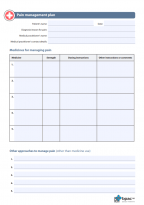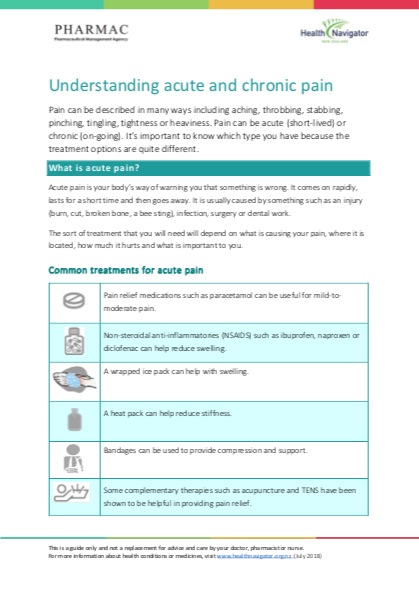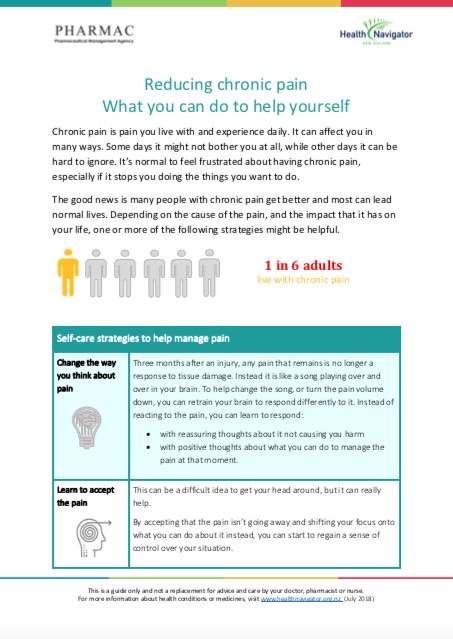Chronic pain is complicated and not easily cured. The goals of treatment are to reduce your pain and increase your ability to do the things you want to do. While medications are a useful option for treating short-term pain, they are not very effective in treating chronic pain and when used in the long-term, can have more side effects. Fortunately, there are a number of other strategies to help you live well with pain.
Video: Tips for managing chronic pain
This video may take a few moments to load.
(Healthify He Puna Waiora, NZ, 2018)
Learn to accept the pain
This can be a difficult idea to get your head around but it can really help. By accepting that the pain isn’t going away and shifting your focus onto what you can do about it instead, you can start to regain a sense of control over your situation.
Change the way you think about pain
Three months after an injury, any pain that remains is no longer a response to tissue damage. Instead it is like a song playing over and over in your brain. To help change the song, or turn the pain volume down, you can retrain your brain to respond differently to it. Instead of reacting to the pain, you can learn to respond:
- with reassuring thoughts about it not causing you harm
- with positive thoughts about what you can do to manage the pain at that moment.
Stay active
For most types of pain, moving more and getting more exercise such as walking, swimming and gentle stretching can help improve muscle strength and reduce pain and stiffness. Try to keep moving throughout the day, rather than having long periods of inactivity followed by short bursts of doing a lot.
Ask your doctor, nurse or physiotherapist to help you create a plan for regular physical activity.
Pace yourself
Avoid doing too much in one go on ‘good days’ then feeling so tired you have to rest all afternoon. Instead, try doing your tasks in stages with rest breaks.
Identify triggers
Certain triggers can make your pain worse. Examples of triggers include alcohol, anxiety and stress, poor sleep habits, negative thinking and over-exertion. Identifying your triggers will help you know what you can do to reduce your pain.
Identify strategies to help you manage stress
Emotional stress and physical pain are closely related, and persistent pain can lead to increased levels of stress. Learning how to deal with your stress in healthy ways can help you to cope more effectively with your chronic pain. Eating well, getting plenty of sleep and engaging in approved physical activity are all positive ways for you to handle your stress and pain.
Distract yourself
Engaging in activities you enjoy will help take your mind off your pain and can help reduce stress, tension and anxiety. Mindfulness is a useful meditation technique that focuses your thoughts away from your pain and directs them in a way that is helpful to managing your pain.
Learn about mindfulness
Mindfulness reduces stress, tension and anxiety. It can help you to avoid focusing too much on your pain as well as directing your thoughts in a way that is helpful for managing your pain. Read more about mindfulness.
Have a support network
Engage family and friends to help you manage your pain. Join a support group or find a hobby that makes you feel good and helps you connect with family, friends or other people. Being engaged and connected can help you feel more positive and experience less pain.
Take a pain-management course
Doing a pain-management course is a useful way to learn about your pain. Ask your healthcare team if there is a self-management or pain course in your area or do an online course such as the free Retrain Pain course(external link)(external link) from the Retrain Pain Foundation. You can also view the New Zealand version of the Pain Self-Care Toolkit or visit the Pain Toolkit website(external link)(external link) and app for more resources.
Consider non-medication treatments
Chronic pain is best managed with a multidisciplinary pain management approach that takes into account the physical, psychological and environmental factors that influence your experience of pain. This usually involves the use of non-medication treatment options.
There are a variety of non-medication-based treatment options to manage pain such as massage, acupuncture, TENS and CBT. Many of these don't have scientific evidence as to whether they benefit or harm people and not all of these will be suitable for everyone. Read more about non-medication treatments for chronic pain.
If your pain persists and is affecting what you can do, ask your doctor or nurse about referral to your local pain service, a pain specialist or pain programme.
Pain relief medicines
Commonly used pain relief medications are not very effective in treating chronic pain and when used long-term, can have more side effects. However, there are some medication that can be used alongside physiotherapy, exercise, balanced diet, relaxation and different ways of thinking and responding to pain. Read more about medicines for chronic pain.









